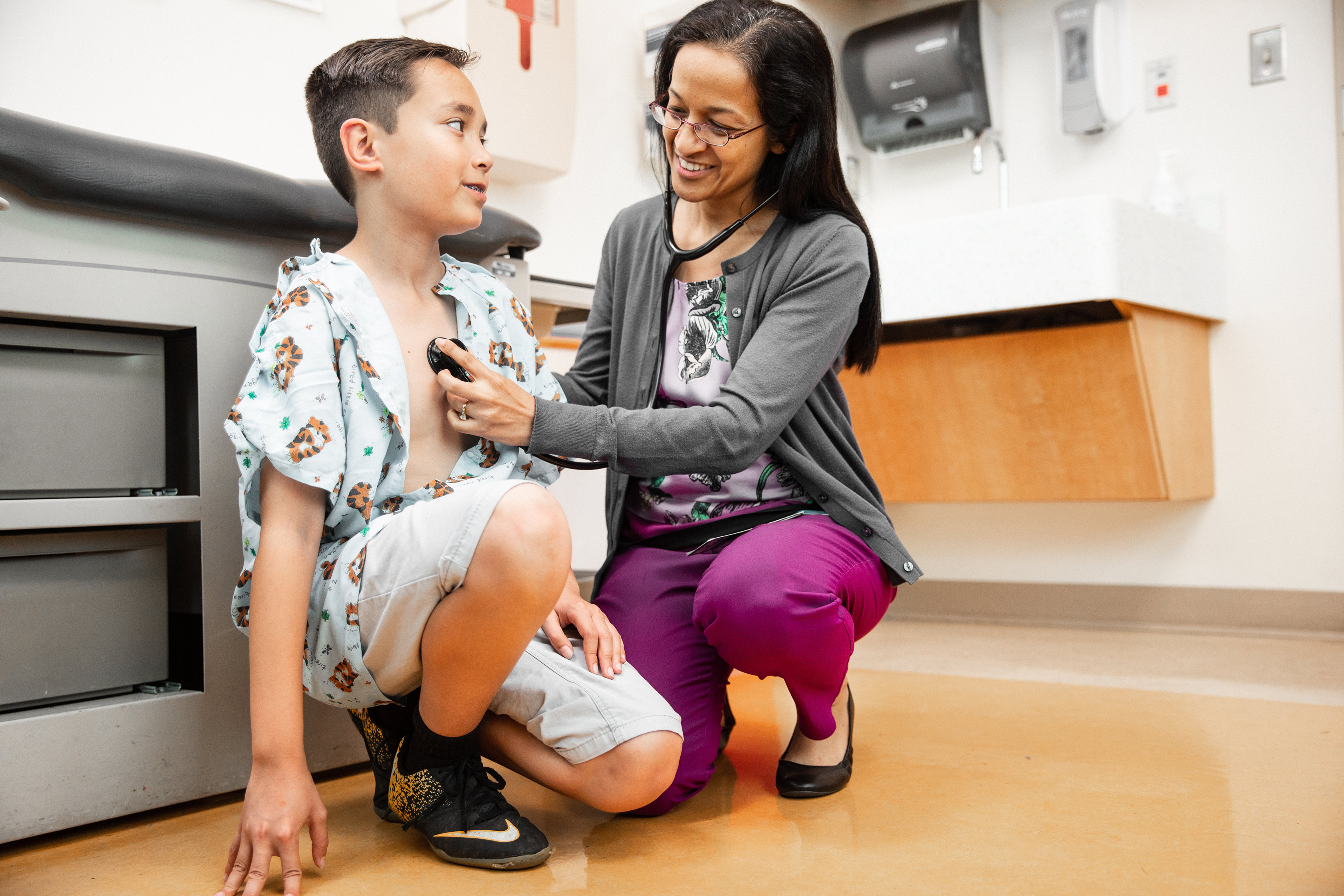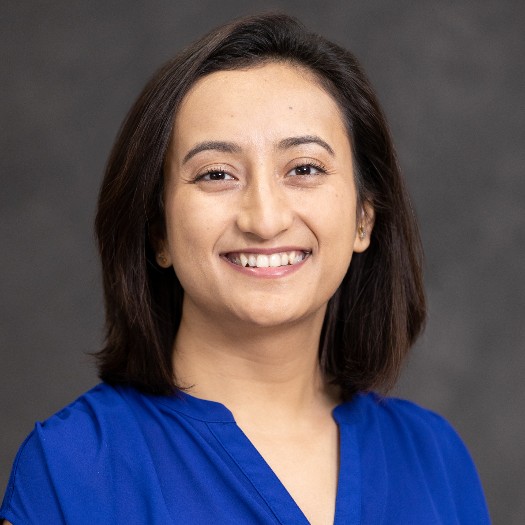Condition
Pediatric Celiac Disease
Key Points About Celiac Disease in Children
- Celiac disease is a digestive problem that hurts your small intestine. It stops your body from taking in nutrients from food.
- Celiac disease is genetic. If a family member has celiac disease, your child has a higher likelihood of developing it.
- Celiac disease can affect all races and genders.
- Celiac disease can sometimes be hard to diagnose because symptoms aren’t always related to digestive problems.
- The only treatment for celiac disease is to stop eating gluten. The body heals itself after gluten is removed from the diet.
Frequently Asked Questions
What is celiac disease?
Celiac disease is a genetic, autoimmune digestive disease that damages the small intestine and interferes with the absorption of nutrients from food. About one in 100 people has celiac disease, making it one of the most common conditions in children.
People who have celiac disease are permanently intolerant to gluten, a protein found in all forms of wheat, rye and barley. Although the common belief is that gluten is found only in foods, the protein is actually used in many everyday products including medications, vitamins and cosmetic products such as lotion, shampoo and lipstick.
What are the symptoms of celiac disease in children?
The symptoms of celiac disease vary greatly among patients and can affect almost any part of the body. One child may experience severe diarrhea and abdominal pain while another may have skin, liver, neurological, dental or other problems. Many children with celiac disease will have problems with growth.
The most common typical and atypical celiac disease symptoms include:
Autoimmune
- Type 1 Diabetes
- Hypothyroidism (including Hashimoto’s Disease)
- Hyperthyroidism (including Grave’s Disease)
- Secondary Hyperparathyroidism
- Sjogren’s Syndrome
- Addison’s Disease
- Autoimmune Liver Disease
- Dilated (congestive) Cardiomyopathy – inflammation of heart muscle
- Alopecia Areata – patchy hair loss
- Rheumatoid Arthritis
- Fibromyalgia
- Collagen-Vascular Disease
- Aphthous stomatitis – canker sores
- Multiple Sclerosis
- Systemic Lupus Erythematosus
- Reynaud’s Syndrome – constriction of blood vessels of hands, feet, fingers and toes
Behavioral/Psychiatric
- Depression – bulk of serotonin found in the intestine, not the brain
- ADD/ADHD/Autism Spectrum Disorder (although no studies have shown a definitive link between celiac disease and ADD/ADHD/autism, many families feel their children have improved on a gluten-free diet)
- Hypochondria
- Inability to concentrate, “brain fog”
- Anxiety
- Neurosis
- Moodiness
- OCD – Obsessive-Compulsive Disorder
Cancers
- Small Intestine Adenocarcinoma
- Lymphoma
- Non-Hodgkin’s Lymphoma
- Melanoma
- Childhood Malignancies
- Thyroid
- Esophageal Carcinoma
Dermatologic and Mucous Membranes
- Dermatitis Herpetiformis
- Eczema
- Psoriasis
- Vitiligo
- Acne
- Rosacea
- Urticaria – hives
- Vasculitis – inflammation of blood vessels
Gastrointestinal
- Diarrhea
- Lactose Intolerance
- Abdominal Distention
- Wasting
- Change in appetite
- Colitis
- Constipation
- Dyspepsia – “stomach aches”
- Bacterial overgrowth
- Malabsorption
- Flatulence
- Reflux/heartburn
- Hepatitis – elevated liver functions
- Pain and bloating
- Ulcers – mouth, esophageal, stomach, upper small intestine
- Vomiting
- CD can be confused with Irritable Bowel Syndrome (IBS), Inflammatory Bowel Disease (IBD), ulcerative colitis and Crohn’s Disease
Hematologic
- Leukopenia – low white blood cell count
- Anemia – iron, folate, B12 deficiency
- Bruising
- Vitamin K deficiency
- Bleeding
- Thrombocytosis – elevated platelet count
- Thrombocytopenia – low platelet count
Neurological
- Peripheral Neuropathies, including Paresthesias – abnormality of sensation; numbness, burning, prickling, itching and/or tingling of hands and feet
- Paraplegia – inability to use legs due to severe neuropathy
- Ataxia – balance disturbance
- Seizures
- Migraines/headaches
- Brain Atrophy and Dementia
Nutritional
- Weight loss
- Stunted growth
- Poor weight gain, “failure to thrive”
- Obesity
- Low blood sugar
Renal
- IgA Nephropathy
Reproductive
- Premature menopause
- Infertility
- Abnormal menstrual cycles
- Spontaneous miscarriage
- Delayed puberty
Respiratory
- Respiratory problems
- Asthma
Skeletal
- Osteoporosis/Osteopenia
- Joint, Bone, Muscle Pain
- Dental Enamel Defects – white or brown spots, ridges on teeth or malformed teeth resulting from typical CD while teeth are forming
- Clubbing – tips of toes and fingers become wide and thick; nails are shiny and abnormally curved
Other Symptoms
- Edema
- Tetany – spasms of hands and feet; muscle cramps
- Fatigue
- Chronic Fatigue Syndrome
- Swelling and inflammation
- Night Blindness
- Chronic infections
- Little or no nail growth
A patient with celiac disease may experience fairly immediate problems such as abdominal pain, bloating or diarrhea after eating gluten-containing foods. However, if the patient continues to eat gluten-containing foods, long-term side effects, such as poor growth, can occur.
How is celiac disease diagnosed in children?
Two types of testing are used to diagnose celiac disease.
The first is a blood test to measure whether there are antibodies (immunoglobulins) to injury, caused by gluten, are in the blood. A person with celiac disease has higher than normal levels of these antibodies in their blood. Antibodies are proteins produced by the immune system in response to substances that the body perceives to be foreign or threatening. For people with celiac disease, the gluten protein is the foreign substance that will cause production of antibodies.
To screen for celiac disease using a blood test, physicians will usually measure levels of:
- Immunoglobulin A (IgA)
- IgA anti-tissue transglutaminase antibodies (anti-tTG IgA)
- IgA anti-endomysial antibodies (EMA IgA)
The screening blood antibody tests are very helpful, but false positive and false negative results can occur. If a person has a positive screening blood antibody test, an experienced healthcare provider will recommend performing a procedure called an endoscopy with a small intestinal biopsy. This procedure is safe, common and quick and should always be performed by an experienced pediatric gastroenterologist.
Almost all children will have the endoscopy and biopsies done under anesthesia, which will guarantee that they will neither feel nor remember the procedure. The endoscope is a thin, flexible tube with a built-in camera system that allows the doctor to see inside the body. The endoscope slides over the tongue, down the esophagus and into the stomach and then the intestine. Using the endoscope, tiny pieces of the intestine are removed to check for damage.
Sometimes a genetic test is done for celiac disease. This test will determine the presence of two genes, HLA-DQ2 and DQ8, which are present in most people with celiac disease and absent in most people who do not have the disease. However, the genetic test cannot give a final answer about whether a person has celiac disease. A positive test is found in about 30-40% of the US population but only about 1% of the population will develop the disease. A negative test makes it very unlikely that a person has celiac disease but does not completely rule it out.
A person must be eating gluten to be tested for celiac disease. If a person stops eating foods with gluten before being tested, the body will stop producing the antibodies that are associated with the injury from gluten. The results of either the screening blood tests or endoscopy with biopsies may be falsely negative.
Who should be tested for celiac disease?
Celiac disease is a hereditary condition, which means it is passed through families. If one family member has the disease, other family members, especially first-degree relatives, should always be tested. First-degree relatives are considered parents, brothers and sisters, or the children of people who have been diagnosed. If a person has celiac disease, approximately 5 - 15% of his/her first-degree relatives will also have the disease.
In families uncertain of their celiac tendencies, it is recommended to test those who have certain chronic conditions and difficult-to-diagnose symptoms.
How is celiac disease in children treated?
The only treatment for celiac disease is a lifelong gluten-free diet, which means eliminating all forms of wheat, rye, and barley. For some patients with celiac disease, starting a gluten-free diet can result in improvement in symptoms in as little as two weeks.
At first, the gluten-free diet can be difficult because gluten is used as a “hidden” ingredient in many processed foods. Recent labeling laws have made it easier to read the labels of food items containing wheat. However, food items containing malt or barley and their derivatives are not covered under those laws so it is very important to carefully read food labels to avoid gluten.
Depending on the child’s age, peer pressure can lead to “cheating,” so it is important to work with a healthcare professional to ensure success. Supportive counseling can help to create proper motivation for parents and children.
What are some foods to avoid for children with celiac disease?
Unlike most diseases, treatment for celiac disease is nutritional and requires the removal of gluten – a protein found in wheat, rye and barley – from the diet. The American Dietetic Association 2006 recommendations for a gluten-free diet are listed below. It is important to check with a healthcare provider before implementing changes to a child’s diet.
Foods to avoid for children with celiac disease:
- Abyssinian hard
Barley grass
Barley hordeum
Barley malt
Bleached flour
Bran
Bread flour
Brewer’s yeast
Brown flour
Bulgur
Bulgur wheat
Cereal binding
Chilton
Club wheat
Common wheat
Couscous
Dextri-Maltose
Disodium
Durum wheat
Edible starch
Einkorn
Emmer
Farina Graham
Farro
Filler
Food starch
Fu (dried wheat gluten)
Germ
Graham flour
Granary flour
Gravy cubes
Groats (barley, wheat)
Ground spices
Hard wheat
Hydrolyzed wheat gluten
Hydrolyzed wheat protein
Hydrolyzed wheat starch
Hydroxyporpyltrimonium Kamut (pasta wheat)
Malt
Malt extract
Malt syrup
Malt flavoring
Malt vinegar
Mir
Miso
Macha wheat
Matzo semolina
Mustard powder
Oriental wheat
Pasta
Pearl barley
Persian wheat
Poulard wheat
Polish wheat
Rice malt
Rye
Seitan
Semolina
Semolina triticum
Shot wheat
Stock cubes
Strong flour
Small spelt
Soba noodles
Spelt
Sprouted wheat or barley
Tabbouleh
Teriyaki sauce
TVP
Timopheevi wheat
Triticale X tritiocosecale
Triticum vulgare
Udon (wheat noodles)
Vavilovi wheat
Vegetable starch
Wheat amino acids
Wheat bulgur
Wheat germ
Wheat protein
Wheat grass
Whole-meal flour
Wild einkorn
What foods are allowed for children with celiac disease?
Unlike most diseases, treatment for celiac disease is nutritional and requires the removal of gluten – a protein found in wheat, rye and barley – from the diet. The American Dietetic Association 2006 recommendations for a gluten-free diet are listed below. It is important to check with a healthcare provider before implementing changes to a child’s diet.
Foods allowed for children with celiac disease:
- Acacia Gum
Acorn Quercus
Adipic Acid
Adzuki Bean
Acacia Gum
Agar
Alfalfa
Algae
Algin
Alginate
Allicin
Almond nut
Aluminum
Amaranth
Annatto
Annatto color
Apple cider vinegar
Arabic gum
Arborio Rice
Arrowroot
Artichokes
Aspartame
Aspic
Ascorbic acid
Astragalus gummifer
Balsamic vinegar
Bean Flours
Benzoic acid
Besan
Betaine
BHA
BHT
Beta Carotene
Biotin
Buckwheat
Butter (check additives)
Butylated Hydroxyanisole
Butyl compounds
Calcium carbonate
Calcium caseinate
Calcium chloride
Caprylic acid
Carboxymethylcellulose
Carnauba wax
Carob bean
Carob flour
Carrageenan Casein
Cellulose
Cellulose gum
Cetyl alcohol
Chorella
Chymosin
Citric acid
Coconut Flour
Collagen
Corn meal
Corn flour
Cornstarch
Corn syrup
Corn syrup solids
Corn sweetener
Cotton seed oil
Cream of tartar
Demineralized whey
Desamido Collagen
Dextrose
Dioctyl sodium
Distilled vinegar
Elastin
Ester gum
Flax
Folic acid/Folate
Formaldehyde
Fructose
Fumaric acid
Gelatin
Glutamate
Glutamine
Glycerides
Glycerol
Gram flour
Guar gum
Herbs
Honey
Hyacinth bean
Hydrolyzed soy protein
Iodine
Invert sugar
Jasmine Rice
Kasha
Keratin
Lactic acid/Lactate
Lactose
Lanolin
Lecithin
Lentils Lipase
Locust bean gum
Maize
Malic acid/Malate
Maltitol
Manioc
Masa
Masa flour
Methyl cellulose
Millet
Milo
Mineral oil
Mineral salts
MSG (made in USA)
Mung bean
Musk
Niacin
Nuts (except wheat, rye, and barley)
Paraffin
Pepsin
Petrolatum
Phenylalanine
Polenta
Polyethylene
Polysorbates
Potassium citrate
Potassium iodide
Potassium sorbates
Potato flour
Potato starch
Propylene glycol
Propyl gallate
Psyllium
Pyridoxine
Quinoa
Ragi
Rape
Reticulin
Rice flour
Rice vinegar
Rosin
Royal jelly
Sago palm
Sago flour
Saifun (bean threads)
Seaweed
Sesame seeds
Sorghum Flour
Sunflower seeds
Sphingolipids
Soba (100% buckwheat)
Sodium acid
Sodium benzoate
Sodium caseinate
Sodium lauryl sulfate
Sodium nitrate
Sodium phosphate
Sorbic acid
Sorbitol-Mannitol
Sorghum
Soy
Soy lecithin
Stearic acid
Sucrose
Sulfites
Sulfur dioxide
Tallow
Tapioca
Tarrow root
Teff flour
Teff
Tofu
Tragacanth
Turmeric
Tyrosine
Waxy maize
Whey
White vinegar
Vitamin A (palmitate)
Xanthan gum
Yam flour

Celiac Disease Treatment at Children's National Hospital
The experts in our Celiac Disease Program are dedicated to developing a national model for detecting and treating celiac disease in children. Discover more about the treatments we offer.

Providers Who Treat Celiac Disease
Geetanjali Bora, MD
Locations
Departments
Christopher Eric Hayes, MD
Locations
Departments
Jul 22, 2024
Helping Maddie to Live Life to the FullestMaddie is a lively, creative teen who loves to act. Research at Children's National Hospital helps to ensure that her rare disease doesn"t upstage her big theater plans or her love of life.
Jun 27, 2024
Convenient Care for CharlotteWhen Charlotte was a toddler, a respiratory illness led to a diagnosis of a rare and dangerous immune deficiency called ICF syndrome. A bone marrow transplant at age 5 at Children’s National helped save her life.
May 20, 2024
Omid Conquers Fear with MusicOmid never liked going to the dentist. Dr. Aleger changed that with a little trust, and his favorite tunes.
Departments that Treat Celiac Disease

Celiac Disease Program
Children’s National is helping to improve the way pediatric celiac disease is diagnosed and treated.

Pediatric Aerodigestive Clinic
Our Aerodigestive Clinic provide specialized care for children with airway problems and feeding disorders.

Bone Health Program - QA
Orthopaedists at Children’s National offer world-renowned expertise and life-changing care, including surgery, for children at high risk for bone fracture.

Gastroenterology, Hepatology and Nutrition
Our gastroenterology experts provide expert diagnosis and treatments for children with digestive, liver and nutrition disorders.







